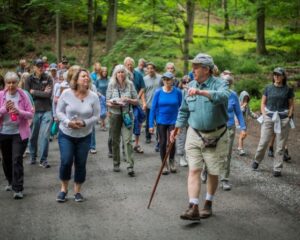Interviewee: Don Hedges (his wife Peggy was also present)
Date of birth/age at interview: June 3, 1905/80
Interviewer: Rita Durrant
Interview date: July 18, 1985
Interview location: unknown
Interview length: 1 hour, 7 minutes
Time span discussed: 1920 to 1985
Summary: Don and Peggy Hedges moved to the New Hope area in the late 1920s. They tell a story of scratching together a living at the beginning of the depression. Don developed an architectural design business and Peggy opened and managed a craft shop across from the bank on Main Street. In 1939 Don was the architect who redesigned the mill into the Bucks County Playhouse, and he relates many stories about this work and subsequent Playhouse history. He relates stories about the Parry sisters, Prohibition, politics in Pennsylvania and New Hope, and local artists.
Time markers:
00:00:00 – Introduction with poor sound quality that eventually improves
00:00:35 – Don born in Idaho, father was a missionary to Blackfoot Indians; mother feared Indians
00:02:20 – grandfather took wagon train across country to Idaho
00:03:38 – Don trained as an architect; started to paint in his 60s
00:03:55 – always interested in art; early schooling in California
00:05:29 – transferred to University of Michigan because cheaper; met Peggy there
00:07:15 – moved to Philadelphia; Don lost job in Depression, moved to New Hope area with brother-in-law with daughter
00:09:11 – opened small shop in New Hope; town was primitive;
00:11:22 – in 1926 paid tolls on road to New Hope; discussion of tolls on roads and bridges
00:13:25 – New Hope streets not paved; paper mill controlled the town; canal still working
00:14:50 – Black Bass and River’s Edge were canal nighttime tie up places; New Hope rough town
00:15:00 – interviewer talks
00:16:57 – pay of carpenters and others during the Depression
00:18:12 – why trees in New Hope died
00:18:50 – their craft shop-a retail gift shop; Peggy ran herself beginning 1938
00:21:37 – first architectural job redesigning the mill in New Hope into the Playhouse; story of the summer theater business before World War II
00:24:10 – the Parry family owned right of way to river; story of the Playhouse patrons, local couples including Childs, Coles, Chapins, Folinsbees, Walkers
00:27:40 – Playhouse changed New Hope; lists area artists; Bill Nye’s style of painting
00:30:25 – Joseph Pickett’s painting and discovery
00:31:38 – Don’s painting style
00:32:55 – Playhouse’s influence on New Hope; Towpath House only restaurant in town; Prohibition
00:35:05 – Parry sisters during prohibition; sisters were fabulous characters
00:37:04 – the Parry brother, Oliver Randolph Parry, and his mistress, officer in World War I and served with Pershing in Mexican War
00:39:15 – Prohibition; still on the hill in Lumberville
00:41:34 – politics during 30s; booze and coal given out for votes
00:43:00 – Dr. Magill was mayor, ran the town with Dr. Turner
00:44:17 – relief houses for the poor; more comments about political corruption at state level
00:47:10 – Committee for the Poor
00:48:10 – no time payments until automobile purchases; President Roosevelt’s started amortizing mortgages
00:50:04 – Playhouse financing stories; opening night show Springtime for Henry with actor Edward Everett Horton; manager Theron Bamberger made the playhouse
00:53:23 – opening night for Moss Hart, George Kaufman, and the Marx brothers in Washington Slept Here
00:56:03 – Playhouse closed during World War II; economics of small theatre after the war, competing for higher paid actors, parking problems limit enlarging theater
01:01:39 – architectural practice in New Hope and Solebury
01:03:10 – George Nakashima
01:03:55 – his architectural work in the area
01:06:00 – changes in the early 1960s, hippies changed New Hope, legacy of drugs
01:06:53 – south Main Street
01:07:26 – north Main Street ; two restaurants: Mother’s and the Landing


